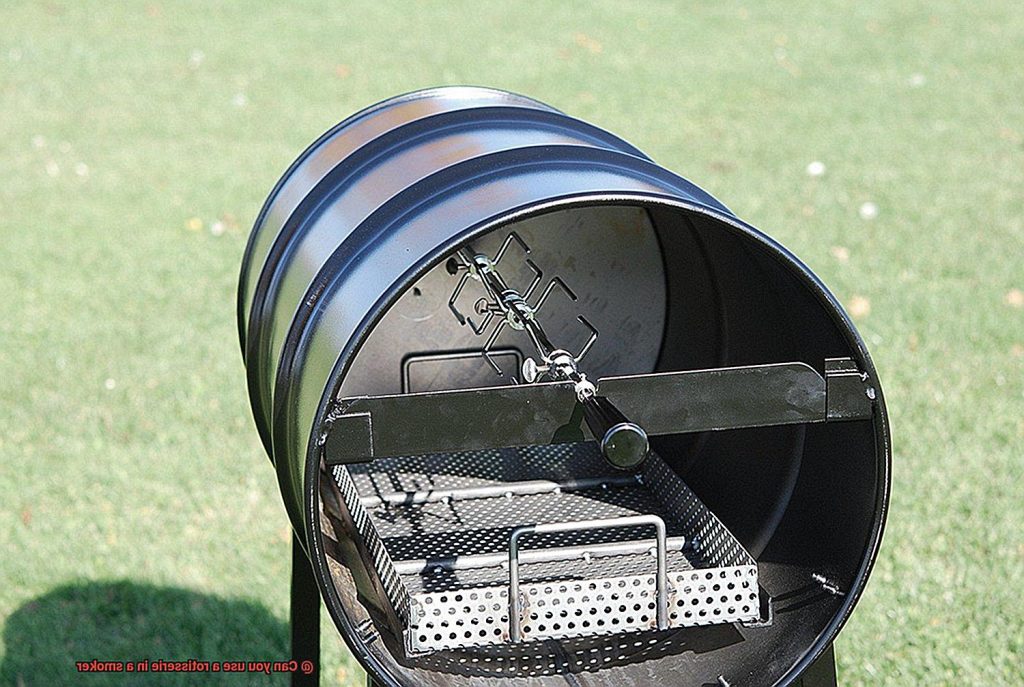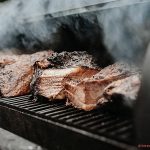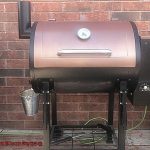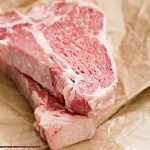Do you consider yourself a BBQ aficionado who’s always on the lookout for new ways to spice up your grill parties? Or maybe you’re just someone who loves experimenting with different cooking methods. Either way, have you ever wondered if you can use a rotisserie in a smoker?
If you’re not familiar with the concept of rotisserie, it involves skewering meat and rotating it over a fire or heat source to cook it evenly. Meanwhile, smokers are devices that use smoke to slowly cook food at low temperatures for an extended period.
Imagine combining these two techniques to create succulent, flavorful rotisserie-style meats infused with smoky goodness. It sounds fantastic, right? But is it possible?
In this blog post, we’ll dive deep into exploring whether using a rotisserie in a smoker is feasible and how to achieve it. We’ll weigh the pros and cons, highlight the necessary equipment, and provide critical tips to help you perfect your smoke-infused rotisserie chicken or pork roast.
Whether you’re an experienced pitmaster or an inquisitive beginner, sit back and relax as we guide you through everything there is to know about using a rotisserie in a smoker.
Contents
What is a Rotisserie?
A rotisserie is a cooking accessory that allows you to roast meat on a spit, which slowly rotates over heat. This method of cooking ensures even heat distribution and results in mouth-watering, flavorful meat that is sure to impress your guests.
One of the great things about rotisserie cooking is that it can be used with various types of meat, including whole chickens, turkeys, pork loins, and roasts. It’s no surprise that rotisseries are often used for special occasions or outdoor gatherings because they provide a unique cooking experience and delicious results.
Rotisseries come in different styles, such as attachments for grills or smokers, or as standalone units. They are available in gas, electric, and charcoal versions. Choosing the right type of rotisserie depends on your cooking preferences and the equipment you have available.
Before delving into rotisserie cooking, there are some important factors to consider. Firstly, make sure your grill or smoker can accommodate the rotisserie attachment and the size of the meat you plan to cook. Proper ventilation is also crucial to ensure smoke and heat circulate around the meat.
Additionally, proper preparation of your meat is key to achieving the perfect flavor and texture. This may involve marinating or seasoning the meat beforehand and trussing it securely onto the rotisserie skewer. Throughout the cooking process, monitor the temperature of your smoker and adjust it as needed.
Benefits of Using a Rotisserie in a Smoker
It’s time to invest in a rotisserie for your smoker. As an expert in the benefits of using a rotisserie in a smoker, I can tell you that it’s a game-changer that will take your grilling game to the next level.
Firstly, the even cooking provided by a rotisserie is unbeatable. Whether you’re smoking a large brisket or pork shoulder, the meat rotates slowly and consistently on the spit, ensuring that it cooks evenly on all sides. No more worrying about overdone or undercooked meat.
In addition to even cooking, using a rotisserie in a smoker also helps keep the meat moist and tender. As the juices from the meat are distributed evenly throughout, it keeps it moist and prevents it from drying out. This results in juicy and delicious cuts of meat that will have your guests begging for seconds.
Using a rotisserie in a smoker also allows for efficient use of space on the grill. You can cook multiple pieces of meat at once instead of having to place each piece individually on the grates. This is especially helpful when cooking for larger groups or smoking multiple types of meat at once.
Steps to Prepare the Meat for Rotisserie Smoking
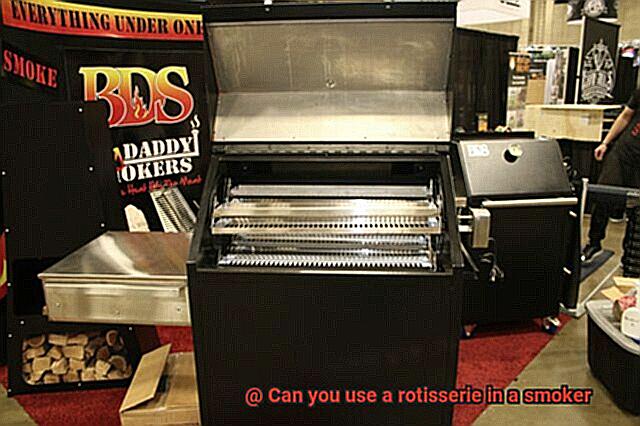
If you want to take your grilling game to the next level and impress your friends and family with juicy, tender meat, rotisserie smoking is the way to go. But before you fire up your smoker, it’s crucial to know how to prepare the meat for rotisserie smoking.
Step 1: Choose the Right Cut of Meat
Selecting the right cut of meat is critical for successful rotisserie smoking. Tender cuts with a good amount of marbling, such as ribeye, sirloin, or beef roast, will cook evenly on the rotisserie and result in mouth-watering, juicy meat.
Step 2: Season it Well
The key to flavorful meat is proper seasoning. Use your favorite dry rub or marinade generously on all sides of the meat, including any nooks and crannies. If you’re using a marinade, let the meat marinate for several hours or overnight to allow the flavors to penetrate the meat.
Step 3: Truss it Up
Tying the meat tightly with kitchen twine is essential for larger cuts like whole chicken or beef roast. Trussing ensures that the meat stays in place while rotating on the rotisserie. Tie the twine tightly but not too tight that it squeezes out the juices of the meat.
Step 4: Preheat Your Smoker
Before placing your trussed meat on the rotisserie, preheat your smoker to your desired temperature. This ensures that the meat cooks evenly and thoroughly.
Step 5: Secure It on the Rotisserie
Once your smoker is preheated, place your trussed meat on the rotisserie spit and secure it tightly with clamps. Keep an eye on the meat as it rotates on the rotisserie and baste it with any leftover marinade or juices from time to time. This will help keep the meat moist and flavorful.
Important Considerations for Choosing the Right Smoker
The key to achieving mouth-watering results lies in choosing the right smoker. With so many different types of smokers on the market, it can be overwhelming to know where to start. This guide will provide you with important considerations for selecting the perfect smoker for rotisserie cooking.
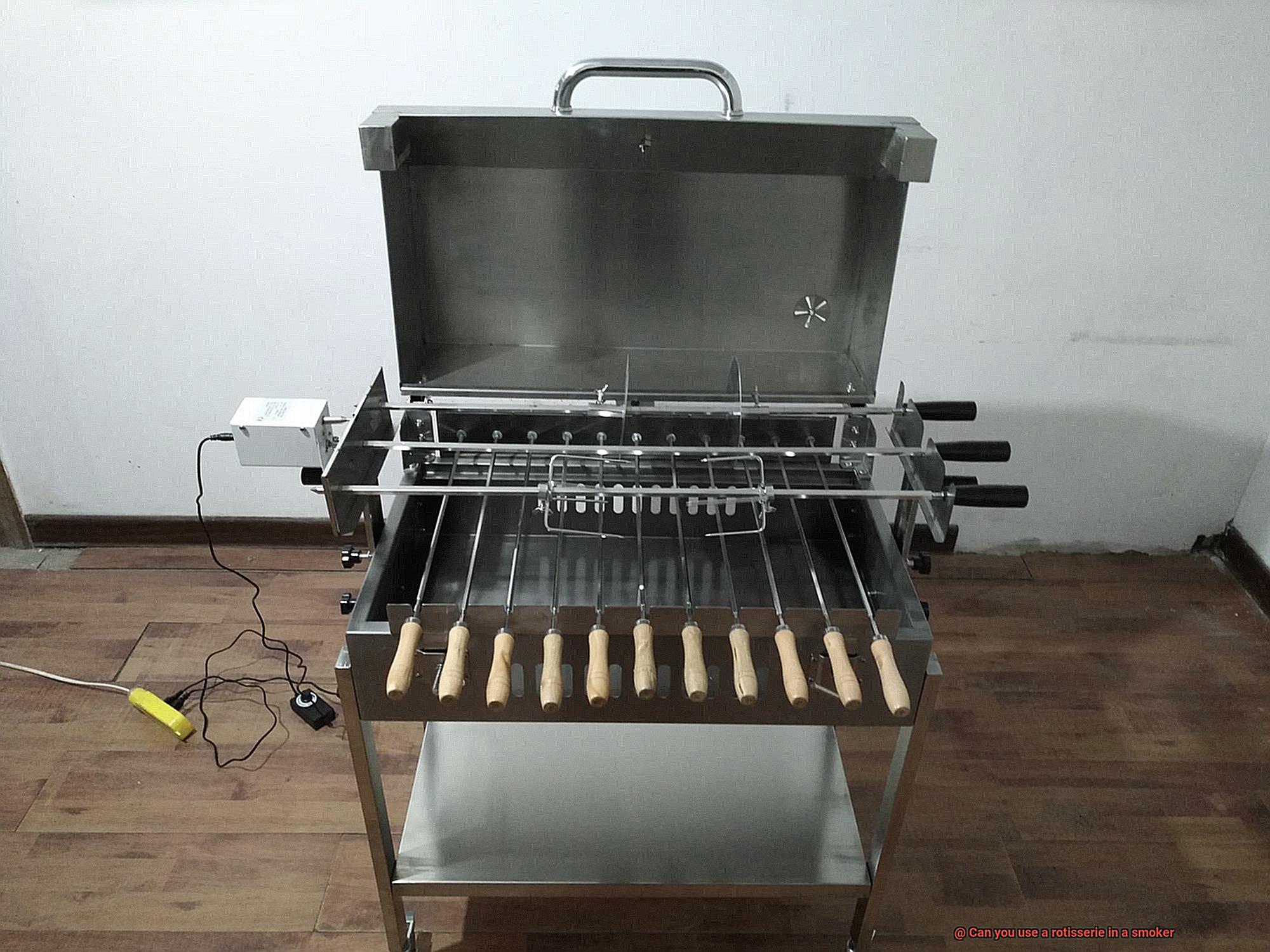
Type of Smoker:
There are several types of smokers available, each with its own advantages and disadvantages. Charcoal smokers are often considered the most authentic way to smoke meat, producing a rich, smoky flavor. Electric smokers are a popular choice among home cooks for their convenience and consistent results but may not come with a built-in rotisserie feature.
Propane smokers are versatile and easy to control temperature but may not have enough space for a rotisserie attachment. Pellet smokers, on the other hand, use compressed wood pellets and are easy to use but may not have a large cooking chamber for bigger cuts of meat.
Size of Cooking Chamber:
When using a rotisserie in a smoker, it’s crucial to factor in the size of the cooking chamber. You want to ensure that there is enough space to accommodate the size of the meat being cooked. If you plan on cooking larger cuts of meat like whole chickens or turkeys, choosing a smoker with a larger cooking chamber is essential.
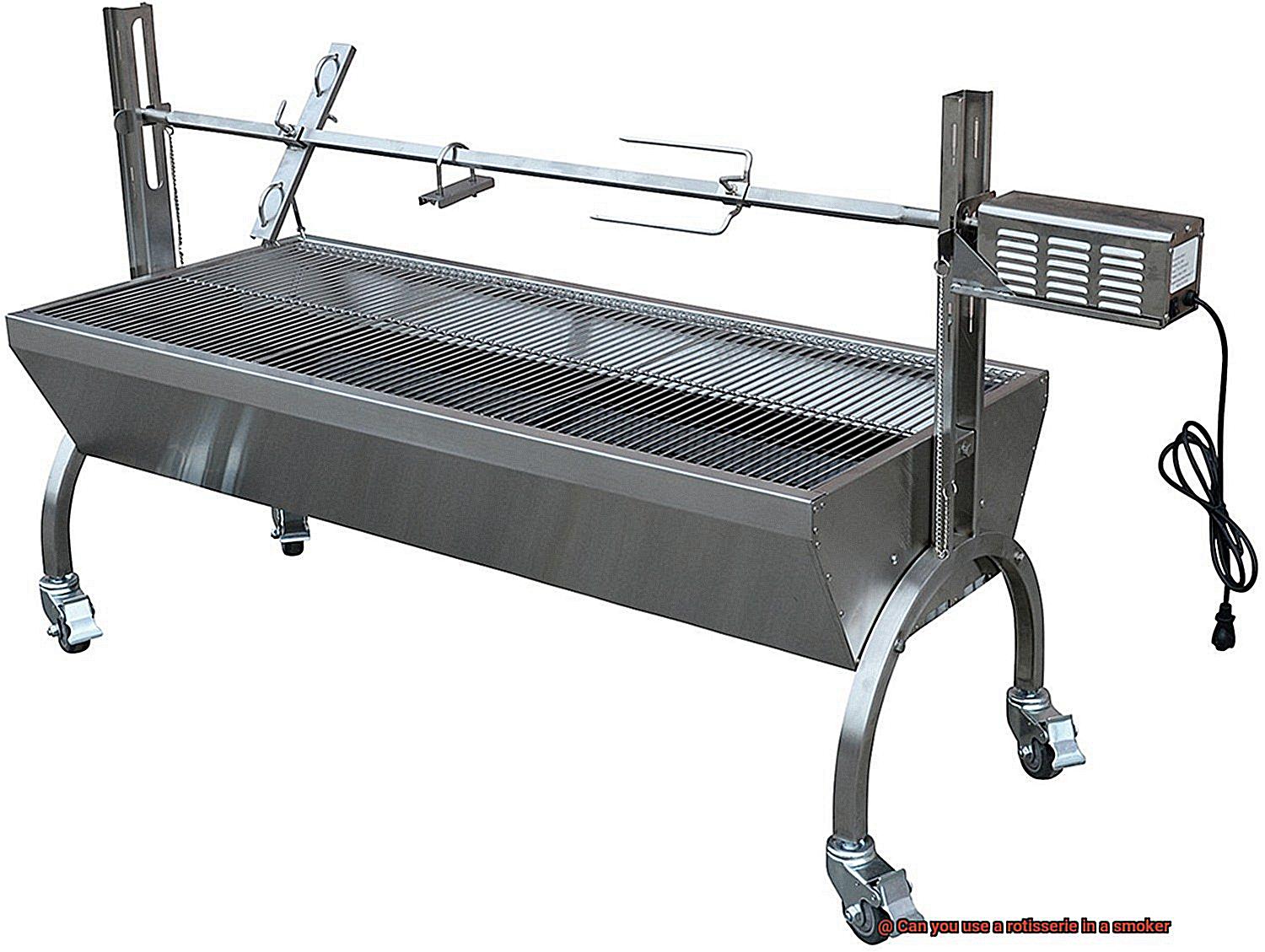
Ease of Access:
Another crucial factor when selecting a smoker for rotisserie cooking is how easy it is to access the meat for basting and monitoring temperature. Some smokers may require you to remove the entire rotisserie assembly just to access the meat, while others have hinged doors or other features that allow for easier access.
Additional Features:
It’s also important to consider additional features that could enhance your rotisserie cooking experience. For example, some smokers come with built-in thermometers or timers, while others offer adjustable racks to accommodate different meat sizes.
Temperature Control and Ventilation Tips for Rotisserie Smoking
If you’re planning to up your grilling game with a rotisserie smoker, then temperature control and ventilation are two elements that can make or break your success. Without careful attention to these factors, your meat may end up overcooked, undercooked, or with a flavor that’s too smoky.
Temperature control is essential in rotisserie smoking. To start, preheat your smoker to the desired temperature before adding your meat. This step ensures that your meat is exposed to a consistent heat throughout the cooking process. It’s also important to monitor the temperature using a built-in thermometer or by manually adjusting vents or dampers if necessary.
Ventilation is equally vital in rotisserie smoking. Keep the exhaust damper open at all times during the smoking process to regulate airflow and maintain a consistent temperature. If your smoker has an intake damper, adjust it accordingly to control the amount of air entering the smoker. However, be careful not to open the damper too much, as this can cause the temperature inside the smoker to rise too quickly.
External factors such as wind and weather can also affect temperature control and ventilation. Choose an appropriate location for your smoker and make necessary adjustments accordingly.
To ensure even cooking, rotate your meat on the rotisserie regularly. This step helps distribute heat evenly and ensures that the meat is cooked to perfection. It’s also important to monitor the internal temperature of the meat regularly using a meat thermometer.
Different types of smokers may require different methods of temperature control and ventilation. Experiment with various techniques until you find what works best for you.
How to Truss Your Meat Before Rotisserie Smoking
Rotisserie smoking is a fantastic way to elevate your grilling game and impress your guests with mouth-watering, juicy meats. But before you start spinning that spit, it’s crucial to know how to truss your meat properly. Trussing involves tying up the meat with kitchen twine to create a compact and uniform shape that will cook evenly on the rotisserie.
To begin the trussing process, place your meat on a clean surface and pat it dry with paper towels. Use a sharp knife to trim any excess fat or uneven portions of the meat to ensure a uniform shape. Then, tie one end of the butcher’s twine around the thickest part of the meat and loop it around tightly, making sure to keep the twine parallel to the spit.
Continue looping the twine around every inch or so until you reach the other end. Be sure to keep the twine tight enough to hold the meat together but not so tight that it cuts into the flesh. Tie off the end of the twine securely and trim any excess.
Trussing not only helps with even cooking but also improves presentation when it comes time to slice and serve your meat. By securing your meat properly, you’ll prevent it from falling apart during the cooking process and ensure that it cooks evenly for tender, juicy results every time.
When you’re ready to cook, secure both ends of the twine to the rotisserie spit, making sure that it is centered and balanced for even cooking. As your meat slowly rotates over the heat, you’ll be rewarded with perfectly cooked, deliciously smoky meat that will have everyone coming back for seconds.
Different Types of Meats That Can Be Cooked on a Rotisserie in a Smoker
Cooking meat on a rotisserie in a smoker is a flavorful and popular way of cooking. By slowly rotating the meat over low heat, it ensures that the meat is evenly cooked and remains juicy. There are various types of meats that can be cooked on a rotisserie in a smoker, each with its unique taste and flavor. In this article, we will explore some of the most popular meats to cook on a rotisserie in a smoker.
Chicken:
One of the most popular meats to cook on a rotisserie in a smoker is chicken. Skewering a whole chicken onto the rotisserie rod and then slowly cooking it over low heat is the key to making juicy, tender meat with crispy skin. This method ensures that the chicken remains moist on the inside while developing a beautiful golden-brown crust on the outside.
Beef:
Beef roasts, such as prime rib or brisket, are perfect for cooking on a rotisserie in a smoker. Slowly skewering beef onto the rotisserie rod and cooking it low and slow for several hours results in perfectly cooked roast with a nice crust on the outside and juicy, tender meat on the inside. The smoky flavor from the smoker only adds to the natural sweetness of the beef.
Pork:
Another great option for cooking on a rotisserie in a smoker is pork. A whole pork loin or pork shoulder can be skewered onto the rotisserie rod and slowly cooked over low heat. This method results in perfectly cooked, juicy meat with a crispy exterior. The smoky flavor from the smoker only enhances the natural sweetness of the pork.
Fish:
Seafood lovers can also enjoy perfectly cooked fish on a rotisserie in a smoker. Whole fish such as salmon or trout can be skewered onto the rotisserie rod and slow-cooked over low heat. This method will result in a perfectly cooked fish with crispy skin and moist, tender flesh. The smoky flavor from the smoker will enhance the natural taste of the fish.
Lamb, Turkey, and Game Meats:
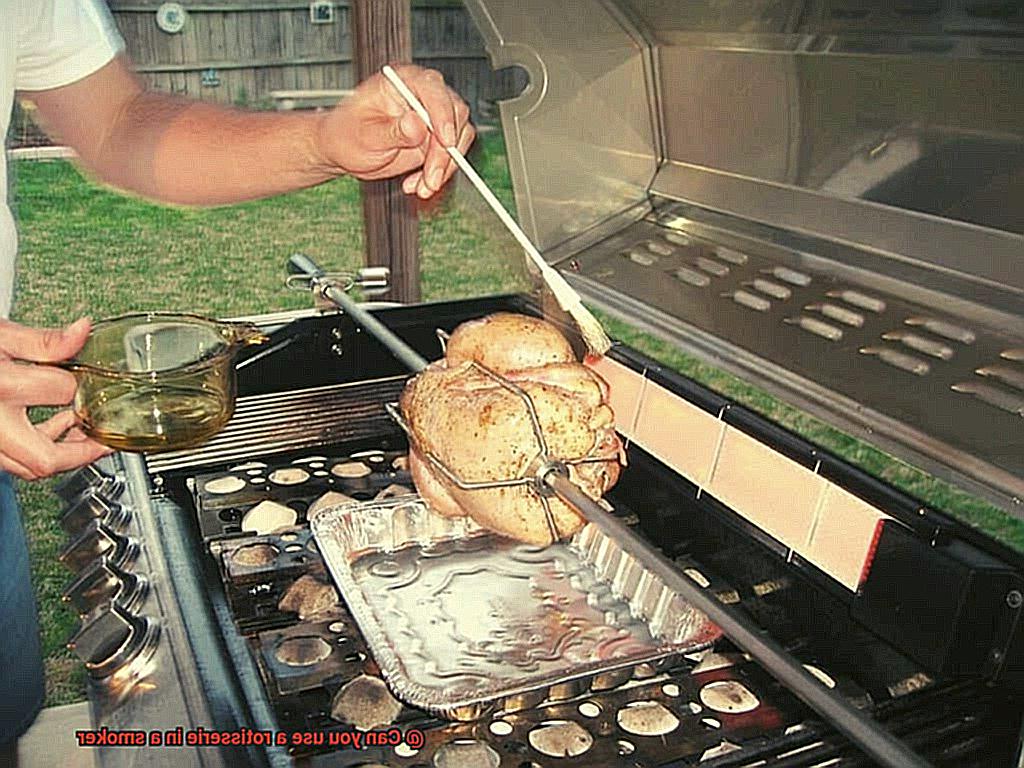
In addition to the meats mentioned above, lamb, turkey, and game meats such as venison or wild boar can also be cooked to perfection on a rotisserie in a smoker. The slow-cooking process allows these meats to remain juicy and tender while developing a delicious smoky flavor that will leave your taste buds craving for more.
Common Mistakes to Avoid When Using a Rotisserie in a Smoker
Many people make common mistakes that can ruin their smoking experience and put their safety at risk. As an expert on the topic, I’ve compiled a comprehensive list of common mistakes to avoid when using a rotisserie in your smoker.
Firstly, it’s crucial to ensure that the meat is properly secured on the spit before starting the rotisserie. Failing to do so can lead to uneven cooking, causing the meat to fall off or cook unevenly. A balanced and secure meat placement ensures even heat distribution and prevents any potential hazards.
Another common mistake is not cleaning your rotisserie after each use. Grease and leftover food particles can accumulate over time and pose a fire hazard while also affecting the taste of your food. Cleaning your rotisserie will keep you safe and prolong its lifespan.
Preheating your smoker is also an essential step that many people overlook. Preheating allows the smoker to reach the desired temperature before inserting your meat, preventing uneven cooking and ensuring that your meat cooks evenly.
Lastly, failing to monitor the temperature of your smoker throughout the cooking process can be a costly mistake. Temperature fluctuations can result in undercooked or overcooked meat, which can be dangerous for consumption. Regularly monitoring the temperature ensures that your food is cooked safely and evenly.
o0FYI10sAP0″ >
Conclusion
In conclusion, combining the power of a rotisserie with a smoker is a culinary game-changer that will take your grilling to the next level. The mouth-watering result is succulent, juicy meats infused with smoky goodness that will leave your guests begging for more. However, before diving into rotisserie cooking, there are several important factors to consider.
Proper preparation is key to achieving the perfect flavor and texture. This may include marinating or seasoning the meat beforehand and trussing it securely onto the rotisserie skewer. Additionally, choosing the right type of smoker and carefully monitoring temperature and ventilation throughout the cooking process are crucial for successful rotisserie smoking.
The beauty of using a rotisserie in a smoker is that you can cook various types of meats, each with its unique taste and flavor. From chicken to beef, pork, fish, lamb, turkey, and game meats – the possibilities are endless.
However, it’s essential to avoid common mistakes such as failing to secure the meat properly on the spit or neglecting to clean your equipment after use. These errors can ruin your smoking experience and even pose safety risks.
By following these tips and tricks, you can elevate your grilling game with delicious meals that will impress even the most discerning BBQ aficionados.

